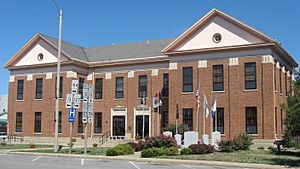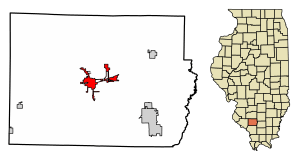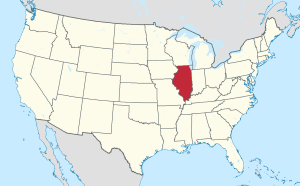Pinckneyville, Illinois facts for kids
Quick facts for kids
Pinckneyville
|
|
|---|---|

Perry County Courthouse, downtown
|
|

Location of Pinckneyville in Perry County, Illinois.
|
|

Location of Illinois in the United States
|
|
| Country | United States |
| State | Illinois |
| County | Perry |
| Area | |
| • Total | 4.38 sq mi (11.35 km2) |
| • Land | 4.11 sq mi (10.64 km2) |
| • Water | 0.28 sq mi (0.71 km2) |
| Elevation | 427 ft (130 m) |
| Population
(2020)
|
|
| • Total | 5,066 |
| • Density | 1,233.80/sq mi (476.34/km2) |
| Time zone | UTC−6 (CST) |
| • Summer (DST) | UTC−5 (CDT) |
| ZIP Code(s) |
62274
|
| Area code(s) | 618 |
| FIPS code | 17-59884 |
| GNIS ID | 2396207 |
| Public Transit | South Central Transit |
| Wikimedia Commons | Pinckneyville, Illinois |
| Website | http://www.ci.pinckneyville.il.us/ |
Pinckneyville is a city in Illinois, United States. It is the main town, or county seat, of Perry County. In 2020, about 5,066 people lived there.
The city is named after Charles Cotesworth Pinckney. He was an important early American diplomat and also ran for president. Pinckneyville is also home to a power plant that helps provide electricity.
Contents
Geography and Location
Pinckneyville is located in southern Illinois. It sits on State Route 13. The city is about 60 miles (96 kilometers) southeast of St. Louis.
The total area of Pinckneyville is about 4.38 square miles (11.35 square kilometers). Most of this area is land. A small part, about 0.28 square miles (0.71 square kilometers), is water.
Population Over Time
| Historical population | |||
|---|---|---|---|
| Census | Pop. | %± | |
| 1860 | 436 | — | |
| 1870 | 773 | 77.3% | |
| 1880 | 964 | 24.7% | |
| 1890 | 1,298 | 34.6% | |
| 1900 | 2,357 | 81.6% | |
| 1910 | 2,722 | 15.5% | |
| 1920 | 2,649 | −2.7% | |
| 1930 | 3,046 | 15.0% | |
| 1940 | 3,146 | 3.3% | |
| 1950 | 3,299 | 4.9% | |
| 1960 | 3,085 | −6.5% | |
| 1970 | 3,377 | 9.5% | |
| 1980 | 3,319 | −1.7% | |
| 1990 | 3,372 | 1.6% | |
| 2000 | 5,464 | 62.0% | |
| 2010 | 5,648 | 3.4% | |
| 2020 | 5,066 | −10.3% | |
| U.S. Decennial Census | |||
The population of Pinckneyville has changed over many years. In 2000, there were 5,464 people living in the city. The city had 1,504 households at that time.
About 14% of the population was under 18 years old in 2000. The average age in the city was 35 years.
History of Pinckneyville
Perry County was created on January 29, 1827. It was named after Commodore Oliver H. Perry. When the county was formed, 20 acres were set aside for the county seat.
On May 17, 1857, Pinckneyville was officially organized. It was named the county seat. Before it was formally organized, in 1834, Pinckneyville had a log courthouse and a few stores. About 20 families lived in the town then.
The first store in Pinckneyville opened in 1827. A jail was built in 1834. A larger jail, which is now a museum, was built in 1871.
Today, Pinckneyville is home to the Illinois Rural Heritage Museum. In 2010, the city received the Governor's Hometown Award.
Education in Pinckneyville
Pinckneyville has several elementary schools. These include District #50, CCSD 204, and St. Bruno Catholic School. Students from Tamaroa grade school also attend high school here.
Pinckneyville Community High School is the only high school for the area. Its mascot is the panther. The school colors are Columbia, Navy, and White. The high school has long-standing sports rivalries with DuQuoin High School and Nashville Community High School.
Pinckneyville is especially known for its boys' basketball team. They have won over 2,000 games. The team has also appeared in the State Finals Tournament 11 times. They won the state championship in 1948, 1994, and 2001.
Notable People from Pinckneyville
- Roy Alden (1863-1937), a newspaper editor and Illinois state senator.
- Albert Brown (1905–2011), the oldest survivor of the Bataan Death March. He moved to Pinckneyville in 1998.
- John Dunn, a former president of Western Michigan University. He was also an interim chancellor at Southern Illinois University Carbondale.
- Ralph A. Dunn, a businessman and Illinois state legislator.
- Marion Rushing (1936–2013), a football player for teams like the Chicago Cardinals and Atlanta Falcons. He is in the Southern Illinois University Hall of Fame.
- Hubert Shurtz (1923–2000), a football player who played for LSU, the Philadelphia Eagles, and the Pittsburgh Steelers.
See also
 In Spanish: Pinckneyville (Illinois) para niños
In Spanish: Pinckneyville (Illinois) para niños

